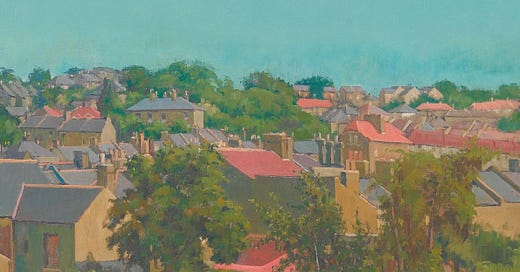Review: Behind the Privet Hedge by Michael Gilson
A surprisingly punchy biography-slash-history of suburbia
I bought Behind the Privet Hedge expecting to find a sleepy, easily digestible jaunt through the history of the common English garden. I had, like many others, fallen for the stereotype of suburbia: how could a quiet, almost desolate place, where exciting things (and new thoughts) find no fertile ground, have an exciting history worth telling?
Gilson opens with a spirited defence of suburbia against those who, at the time it was being built in the 20s and 30s, had nothing but scorn for it. Progressive architects saw the suburbs as dangerously boring, destroying green space with cookie-cutter buildings and blurring the edges between town and rural. Left-wing radicals disparaged them as opium for the masses, encouraging the working class to think more about growing petunias than fighting for social change. The old rich - poets and writers from landed estates, the heirs of Romantic tradition - saw them almost like an invader, paving over ancient and unique green spaces with same-same boxy houses, erasing the very core of Englishness.
There were precious few willing to defend the suburbs or the new folks who lived in them. Many were urban poor or working-class families who had seen fathers sent off to die in war, who had grown up in inner-city slums with no more than a 4x4m yard to take care of, if they were lucky. These people, scarred by pollution and conflict, needed new homes. They needed gardens.
Enter Richard Sudell.
A quaker, a left winger, and a conscientious objector, Sudell was imprisoned in the First World War for refusing conscription (he would later say that far too many statues had been built of men who led others to death than of gardeners, showing his lifelong dedication to pacifism). Freed from captivity, he set out on a mission to ‘greenify,’ as we would say today, urban spaces. His beginnings were amazingly humble: with little education to speak of, he started by arranging window-box competitions for slum dwellers, encouraging them to turn their windowsills into small slices of Eden.
As the suburbs grew, he brought his practical plant knowledge to a wider audience with newspaper columns and, later, advice books - publishing nearly 50 over the course of his life. Sudell understood what the new suburbanites needed: not scorn, not criticism nor philosophical arguments over whether or not they should be there, but gardening advice. Many had never grown so much as a daisy before, and they had been left by the builders with 100m-square patches of bare, brown earth, and no idea what to do with it.
The suburbs were a radical solution to generations of poverty and neglect. The importance of nature and green spaces for our mental and physical health is universally accepted now, but the gardeners like Sudell who fought for it a century ago were fringe figures. When architects and town planners wanted to cram people into brown-brick tenements in city centres and label it futurism, ever-practical Sudell understood that what they really needed was a place to call their own, a secure and peaceful place where they could, in his words, retreat ‘from the toil of the day.’ It is notable that today, a hundred years on, the UK’s housing stock looks so different to that of its closest neighbours (according to Eurostat, 46% of EU citizens lived in apartments in 2019, compared to 21.7% in the UK (ONS, 2021)). The fight for the places we live in - the places we spend more time than anywhere else - was settled a century ago, on invisible battlefields that have fallen from memory, but still has a resounding impact on our everyday lives. Gilson’s book brings that struggle back to the fore.
Gilson has grafted the tree of Sudell’s biography onto the rootstock of suburban history - and for the most part it is an inspired decision. He weaves the two together deftly and the seams are largely invisible; but they do stick out in parts, and some passages felt more relevant than others. I found myself skim-reading the short section on Guyana, which felt as strangely out of place here as Sudell himself presumably felt when he was sent there. Some transitions were difficult: the few chapters covering the rest of Sudell’s biography, beginning about 2/3rds of the way through, felt slightly unmoored, but the book would have felt incomplete if Sudell’s whole story had not been told.
Regardless, I have no doubt this is an essential read. The history of the suburbs is almost unknown. We accept suburbia’s presence and scoff at those who live there without asking why it was built and where it came from. Gilson shines a light on it, and reveals that the stolid, ever-there suburbs are not that old at all, and they have a radical past.
It is also surprisingly relevant. We are, as Gilson reveals towards the end of the book, going through yet another evolution in suburbia. Our love of cars and our new multi-generational households mean many front gardens are being torn up and turned into small car parks. Wealth and populations are moving away from the suburbs for the first time. And record housing prices are creating a social upheaval unseen since the first days of suburbia. While we don’t know where the pieces will fall yet, it feels as though British housing is reaching another fork in the road, which makes a book on its history even more timely.




